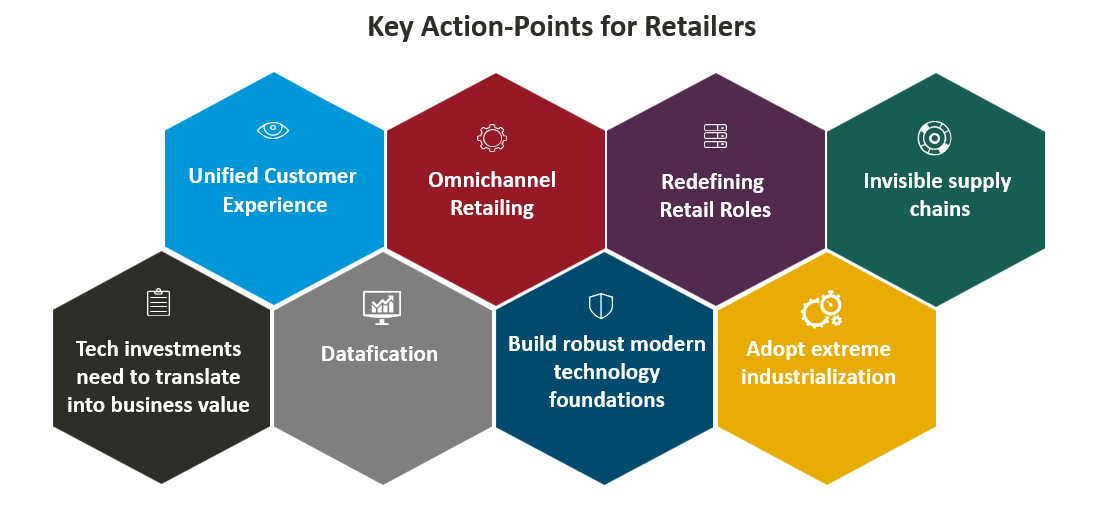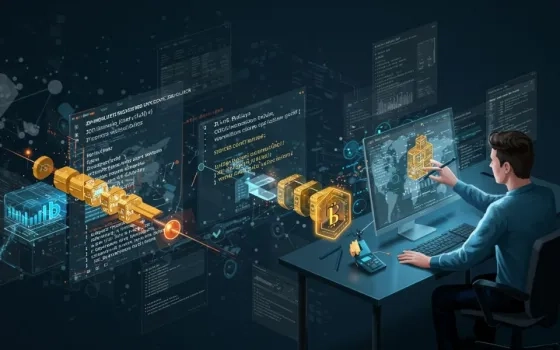This is the second blog of a three-part series on Digital Transformation in the Retail space. The last and final blog will outline some of the key technologies disrupting the retail space, technology priorities in the next 3-5 years, as well as key trends pertaining to technology investments, digital spend focus areas, digital workforce, talent sourcing strategy and enterprise readiness to adopt a hybrid work mode as elucidated in NASSCOM-Avasant's report titled “DIGITAL ENTERPRISE MATURITY 3.0: Boosting Business Resilience through Technology” published in July’2022.
The world is now coming to terms with the ‘new normal’ or ‘next normal’ being the ‘normal’. And to stay relevant, ‘change truly is the only constant’ that human beings and enterprises alike need to embrace. In order to stay relevant in today’s ever-changing environment of Volatility, Uncertainty, Complexity, and Ambiguity (VUCA), modern businesses need to reconsider their strategies. And digital transformation finds its way as a critical business imperative in those boardroom and senior-level strategic discussions.
The retail industry, in particular, has been restructured by numerous factors, such as the exponential growth of e-commerce and omnichannel, shifting customer behaviours and hyper-personalization, and increasing supply chain disruptions, all of which have been intensified by the pandemic. Resultingly, these shifts have exacerbated the pressure on retailers’ top and bottom line. Digital transformation, thus, becomes necessary and is no longer discretionary; the pace, level, and nature of tech adoption, as well as the seamlessness with which systems and processes talk to each other, will be the key differentiator. In today’s dynamic scenario, the key action-points players in the retail space need to adopt to keep pace with the changing face of the retail industry as follows:
- Unified Customer Experience
Customers today want to leverage multiple channels – web, mobile, social media, etc. – making it imperative for retailers to implement a unified commerce strategy, wherein a distinct, completely integrated software platform can manage different systems from a single interface. Further, to ensure data security and privacy, data siloes need to be disintegrated, and data from different sources needs to be combined into a unified commerce system.
- Omnichannel Retailing
Retailers need to differentiate customer experiences through solutions such as omnichannel. For instance, bringing increased in-store experiences online, virtual showrooms, etc. can help customers leverage the in-store experience from the comfort of their home. Further, technologies like Augmented Reality (AR)/Virtual Reality (VR) can help customers visualize products, looks, experiences, etc. on their mobile devices. Moreover, novel delivery models such as BOPIS (buy online, pick up in-store) introduced during Covid continue to gain traction. Retailers need to be able to deliver a unique, consistent customer experience across channels by transitioning to a headless commerce architecture that supports all consumer touchpoints from, say, wish lists to appointment booking to payments. Digital transformation can fuel the omnichannel experience customized in line with consumer's needs and expectations using instant satisfaction, tailored push notifications, projection of market trends, strategic analysis, shaping of location-based strategy and estimating shipping costs and times, to be able to fulfil consumer demands across all channels.
- Redefining Retail Roles
Brick-and-mortar stores could actually help augment eCommerce sales. Studies have shown that opening a new physical store ramps up the average gain in overall traffic to a retailer’s website and further upsurges its web traffic share within that market. Retailers can thus leverage the ’phy-gital’ model to drive sales. Illustratively, Amazon combines its physical stores, Whole Foods, and Amazon Go (with cashierless/self-checkout stations), to culminate in-person and digital experiences.
- Invisible supply chains
The world is still reeling under the impact of Covid-induced supply-chain disruptions and technology could be the perfect solution to this problem. To avoid stock-outs and delays, retailers need to embrace digital transformation to create swift, transparent, and resilient supply chains that can ensure shortened delivery times at minimum cost and maximum efficiency.

- Tech investments need to translate into business value
The expenses required to ‘keep systems running’ need to be substituted by those that generate value in terms of strategic priorities as well as provide for exploration of new business models. A steering committee comprising of business and tech teams needs to collectively evaluate and assess existing tech investments and reprioritize future investments to generate additional business value.
- Datafication
Data-driven business insights add greater value to the business. Data integration used to implement specific use cases can help unlock accelerated value. Fragmented data across systems in on-premises architecture has limited scalability and to unlock the full power of data, retail enterprises need to execute cloud-based data platforms that enable automation.
- Build robust modern technology foundations
Upgrading tech foundation and enhancing the speed of development of new solutions is key in today’s competitive retail landscape. Automation of processes and cloudification of data is essential, but so is piloting projects on nascent technologies like Web 3.0., Metaverse, etc. Retailers can also gain by deep-diving into systems: disintegrating monolithic solutions to build a microservice-based architecture that can improve flexibility and reusability while speeding up delivery.
- Adopt extreme industrialization
Speed and scale are both critical priorities for retailers. Breaking down barriers of organizational silos by creating cross-functional teams (for instance, engineers, architects, designers, product developers led by business heads) not only promotes collaboration but also helps provide frictionless offerings to end-users. The cross-functional teams with the help of highly automated software delivery pipelines can manage point-to-point delivery of the retailer’s solutions and thus, significantly accelerate the delivery of new features to consumers.
The modern-day consumer wants increased flexibility, personalization, and responsiveness, to attain which retailers would need to expedite their digital transformation journey, including even a complete revamp of their tech architecture and operating model at times. The benefits of digital adoption will translate into a robust top and bottom line eventually.
For more information on Digital Transformation across sectors (including Retail) and Digital Enterprise Maturity, please refer to the report downloadable at the following links:
NASSCOM Website: https://nasscom.in/knowledge-center/publications/digital-enterprise-maturity-30-boosting-business-resilience-through
NASSCOM Community: https://community.nasscom.in/communities/digital-transformation/digital-enterprise-maturity-30-boosting-business-resilience
Earlier versions of the report can be downloaded from the following links:
A NEW ORDER OUT OF CHAOS-BUILDING A FUTURE READY ORGANISATION-https://community.nasscom.in/communities/digital-transformation/new-order-out-chaos-building-future-ready-organisation
REIMAGINING INDIAN ENTERPRISES' TECH LANDSCAPE IN A DIGITAL-FIRST WORLD – A NEW ORDER OUT OF CHAOS- https://community.nasscom.in/communities/digital-transformation/reimagining-indian-enterprises-tech-landscape-digital-first
DEFINING THE DIGITAL ENTERPRISE - MAR 2020 -https://community.nasscom.in/communities/digital-transformation/defining-the-digital-enterprise-mar-2020.html
Sources:
- The tech transformation imperative in retail
- Digital Transformation in Retail: Why It’s Important & How to Achieve It
- Digital Transformation in the Retail Industry: Trends, Challenges, and Examples
- Why digital transformation is important in retail and how to get started





















